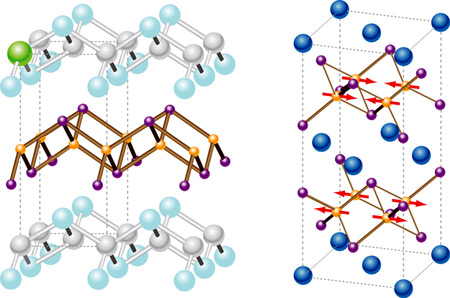
In any superconductor, resistance-free flow sets in below a certain "critical temperature" when the electrons somehow pair to waltz along unimpeded. The question is, how do the electrons, which ordinarily repel one another, attract one another instead? In an ordinary superconductor, such as the metal niobium chilled to below 9.3 kelvin, vibrations provide the necessary "glue." An electron zipping through the material sets off a quantized vibration, or "phonon," that draws another electron in its wake. Formulated in 1957, this scheme neatly explained every superconductor known at the time and for decades to come.
But in 1986, things got more complicated. Physicists discovered a new family of superconductors that all contain planes of copper and oxygen atoms and work at much higher temperatures: now as high as 138 kelvin. The delicate bonds formed by phonons should surely melt at such temperatures, and these high-temperature superconductors--known as cuprates--have defied complete explanation for 22 years. That's why researchers were excited by the discovery of the iron-and-arsenic compounds last year (ScienceNOW, 17 April 2008): By comparing them with the cuprates, physicists hope that they might be able to figure out both superconductor families at once.
Now, Xianhui Chen, a physicist at the University of Science and Technology of China in Hefei, and colleagues have shown that phonons play an important role in the iron-and-arsenic superconductors. That's a bit of a surprise, as physicists generally think that phonons play at most a minor role in the cuprates. To probe the role of phonons, the researchers studied two of the complicated iron-and-arsenic superconductors: samarium iron arsenic oxide seasoned, or "doped," with fluorine and barium iron arsenide similarly doped with potassium. The researchers produced samples containing iron atoms with different weights--either atoms of the heavier "isotope," iron-56, or the lighter iron-54.
Replacing the heavier ions with the lighter ones should make the phonons vibrate slightly faster. Then, if phonons do play a role in pairing, the superconductor's critical temperature should change, too, (in ordinary superconductors, it goes up). And that's just what Chen and colleagues observed in their samples. In both the samarium compound and the barium compound, the critical temperatures of the light-isotope versions were half a kelvin higher than those of the heavy versions, as the physicists report this week in Nature.
Does that "isotope shift" prove that vibrations provide the glue in the new materials after all? No, says, Lilia Boeri, a theorist at the Max Planck Institute for Solid State Physics in Stuttgart, Germany. Chen and colleagues also tested undoped, nonsuperconducting variants of the samarium and barium compounds, which undergo a transition of a different type: They become magnetized in an odd way with neighboring rows of iron ions pointing in opposite directions. Chen's team showed that switching the iron isotopes also increases the temperature for the magnetic transition by half a degree. That parallel rise, Boeri says, suggests that phonons in the superconducting compounds shepherd electrons in a novel and indirect way, by interacting with magnetic fluctuations that then glue the electrons together. "In my opinion, this result is a confirmation that these are exotic superconductors" and not ordinary ones, she says.
But what does the result imply for the mysterious cuprates? Physicists have generally assumed that phonons play little role in them, in part because the materials show no isotope shift, Chen says. But that's only at optimal doping, he says; at low doping levels, they show a big shift. "To be honest, I don't understand why theorists ignore this," Chen says. He says it's time to reconsider the role of phonons in the cuprates. Boeri says that some theorists have already begun to do that.



Reader Comments
to our Newsletter